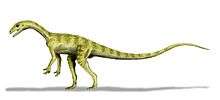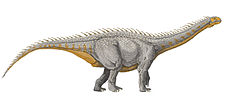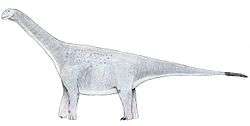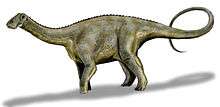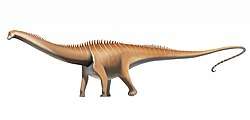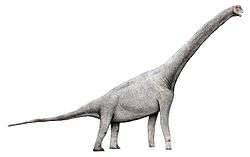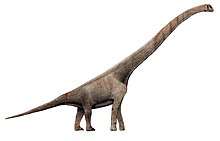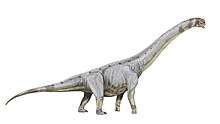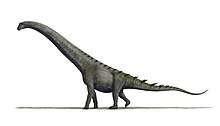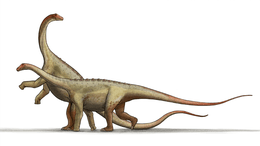Sarahsaurus
Sarahsaurus is a genus of basal sauropodomorph dinosaur which lived during the lower Jurassic period in what is now northeastern Arizona, United States.[2]
| Sarahsaurus | |
|---|---|
 | |
| Illustration of the skull in multiple views | |
| Scientific classification | |
| Kingdom: | Animalia |
| Phylum: | Chordata |
| Clade: | Dinosauria |
| Clade: | Saurischia |
| Suborder: | †Sauropodomorpha |
| Clade: | †Massopoda |
| Genus: | †Sarahsaurus Rowe, Sues & Reisz, 2011 |
| Species: | †S. aurifontanalis |
| Binomial name | |
| †Sarahsaurus aurifontanalis Rowe, Sues & Reisz, 2011 | |
Discovery and naming

All specimens of Sarahsaurus were collected from the Early Jurassic Kayenta Formation near Gold Spring, Arizona.[2] The genus is based on a nearly complete and articulated (with bones still connected to each other) skeleton with a fragmentary and disarticulated skull (holotype, specimen number TMM 43646-2). In addition, a partial skeleton (specimen number TMM 43646-3) as well as a nearly complete skull (specimen number MCZ 8893) was assigned to the genus.[2] The latter specimen was originally referred to as Massospondylus sp.[3] The complete skull is crushed and split horizontally, separating the skull roof from the palate; this split was caused by periodic swelling and shrinkage of the surrounding clay after burial. While the holotype individual was mature, the second skull indicates a less mature individual as indicated by open suture lines that separate skull bones of the braincase (the bones enclosing the brain).[2][1]
Sarahsaurus was first described by Timothy B. Rowe, Hans-Dieter Sues and Robert R. Reisz in 2011; the type species is Sarahsaurus aurifontanalis. The generic name honours Sarah Butler and is derived from the Greek sauros meaning "lizard". The specific name is derived from aurum (Latin), "gold", and fontanalis (Latin), "of the spring" in reference to Gold Spring, Arizona, where the holotype was found. Sarahsaurus is the fourth basal sauropodomorph dinosaur to have been identified in North America; the other three are Anchisaurus and Ammosaurus from the Early Jurassic of the Connecticut River Valley, and Seitaad of the later Navajo Sandstone of Early Jurassic Utah. It is thought to have appeared through a dispersal event that originated in South America and was separate from those of the other two sauropodomorphs.[2] The animal is notable for possessing very large, powerful hands, possibly suggesting that it was an omnivore.[4]
Description
Sarahsaurus was a basal (or "primitive") member of the sauropodomorph lineage, which also included the more derived (or "advanced") sauropods – giant four-legged herbivores (plant-eaters) with long necks and tails. Basal sauropodomorphs such as Sarahsaurus already resemble sauropods in a number of aspects, including the elongated neck and robust build, but are reminiscent of the ancestral dinosaurs in others: Sarahsaurus was bipedal (two-legged), with forelimbs that were much shorter than the hind limbs and equipped with powerful grasping hands.[5][1] Sarahsaurus was mid-sized for a basal sauropodomorph, with its vertebral column measuring more than 3.1 metres (10 ft) in length.[1] Paleontologist Gregory Paul, in a 2016 popular book, estimated its length at 4 metres (13 ft) and its body weight at 200 kilograms (440 lb).[6]
Skull
The external naris (skull opening for the nostril) was less than half the size of the orbit (eye socket). It was bordered by the nasal, premaxilla, and, to a small extent, the maxilla, the latter two forming the upper jaw. Between the premaxilla and maxilla there was a large opening, the subnarial foramen. The antorbital fossa, an additional skull opening seen in most dinosaurs that was situated between the external naris and orbit, was less then half the length of the orbit. Much of the upper margin of the orbit was formed by the frontal bone of the skull roof; this bone, however, did not contribute to the front margin of the upper temporal fenestra at the rear end of the skull roof. Instead, this front margin was formed by the postorbital and parietal bones, with the front part of the parietal being forked to connect with the latter. Between the parietal and the supraoccipital, which follows behind the parietal at the back of the skull, was another opening, the postparietal fenestra, which was large in Sarahsaurus. A unique feature of the genus can be found on the underside of the braincase, where a shallow ridge spanned between the basipterygoid processes, bony downwards projections of the braincase that brace the latter against the palate. The lower jaw curved downwards towards its tip, and the jaw joint was located well below the level of the tooth row. There is no evidence for a beak.[2][1]
Each side of the upper jaw was lined with 20 teeth – four in the premaxilla, the front bone of the upper jaw, and 16 in the maxilla which followed behind. The dentary bone of the lower jaw likewise had 20 teeth. The teeth were moderately heterodont, i.e., tooth shape varied within the jaw, and sat slightly obliquely in the jaw, slightly overlapping each other. Their cutting edges were serrated with up to 20 denticles per tooth.[2]
Postcranium
The spine comprised 10 cervical (neck) vertebrae; 14 dorsal (trunk) vertebrae; three sacral (hip) vertebrae; and ca. 50 caudal (tail) vertebrae. In contrast to the later sauropods, the sides of the dorsal vertebrae did not show deep cavities caused by air sacs invading the bone (postcranial skeletal pneumaticity). The scapula (shoulder blade) was hourglass-shaped. In the holotype specimen, the scapula and coracoid were unfused, probably connected only via cartilage; this might indicate that the individual was not yet fully mature. The holotype specimen includes the sternum (breatbone) and the clavicle (collarbone), which are rarely found with dinosaur skeletons. The clavicula is a rod-like bone that articulates with the lower end of the scapula in an immobile joint. It has been controversial if the left and right clavicles of sauropodomorphs were attached to each other at their ends, thus connecting the left and right shoulder girdles, or if they were pressed against their scapulae along their lengths. The orientation of the clavicle in Sarahsaurus confirms that the former was the case; the ends of both clavicles would probably have been connected to each other by a ligament, though they were not fused. In side view, the scapula was tilted between 45° and 65° relative to the horizontal. This would have allowed the left and right coracoids to almost touch each other at the body midline, while the left and right sterna, which were attached to each other at the midline, would have been located directly behind the coracoids.[2][1]
The humerus (upper arm bone) was more than half the length of the femur (upper thigh bone), and had a large crest on its front side for muscle attachment, the deltopectoral crest, which extended for half the length of the bone and had a S-shaped edge. In the hand, the ungual (claw bone) of the first finger was the largest.[2]
In the hip, the ilium had two downwards-facing bony projections, the ischial and pubic peduncle, which connected to the two lower hip bones, the ischium and the pubis, respectively, as in other dinosaurs. In Sarahsaurus, the ischial peduncle was only half the length of the pubic peduncle. The acetabulum (hip joint) was formed by all three hip bones, as in other dinosaurs, though in Sarahsaurus the ischium contributed less than half as much as the pubis. The pubis was unique in having two separate openings, the obturator foramen and the pubic foramen; the latter was lacking in most other archosaurs. The femur was straight and elliptical in cross-section. The tibia (shin bone) reached 84% of the length of the femur.[2]
Classification

In a cladistic analysis, presented by Apaldetti and colleagues in November 2011, Sarahsaurus was found to be most closely related to Ignavusaurus within Massopoda. Their group was found to be intermediate between plateosaurids and massospondylids, being more derived than the former and more primitive than the latter.[7] A 2018 cladistic analysis by Chapelle and Choiniere recovered Sarahsaurus and Ignavusaurus as massospondylids, mirroring the original assignemt of Sarahsaurus to Massospondylus.[8]
| Plateosauria |
| |||||||||||||||||||||||||||||||||||||||||||||||||||||||||||||||||||||||||||||||||||||||||||||||||||
Paleoecology
Age and habitat
A definitive radiometric dating of the Kayenta Formation has not yet been made, and the available stratigraphic correlation has been based on a combination of radiometric dates from vertebrate fossils, magnetostratigraphy and pollen evidence.[9] It has been surmised that the Kayenta Formation was deposited during the Sinemurian and Pliensbachian stages of the Early Jurassic Period or approximately 199 to 182 million years ago.[10] The Kayenta Formation is part of the Glen Canyon Group that includes formations not only in northern Arizona but also parts of southeastern Utah, western Colorado, and northwestern New Mexico. The formation was primarily deposited by rivers. During the Early Jurassic period, the land that is now the Kayenta Formation experienced rainy summers and dry winters. By the Middle Jurassic period it was being encroached upon from the north by a sandy dune field that would become the Navajo Sandstone.[11] The animals here were adapted to a seasonal climate and abundant water could be found in streams, ponds and lakes.
Paleofauna
Sarahsaurus shared its paleoenvironment with other dinosaurs, such as several theropods including Dilophosaurus, Kayentavenator,[12] Coelophyisis kayentakatae, and the "Shake N Bake" theropod, and the armored dinosaurs Scelidosaurus and Scutellosaurus. The Kayenta Formation has yielded a small but growing assemblage of organisms.[13] Vertebrates present in the Kayenta Formation at the time of Saharasaurus included hybodont sharks, indeterminate bony fish, lungfish, salamanders, the frog Prosalirus, the caecilian Eocaecilia, the turtle Kayentachelys, a sphenodontian reptile, various lizards, and the pterosaur Rhamphinion. Also present were the synapsids Dinnebitodon, Kayentatherium, Oligokyphus, morganucodontids, the possible early true mammal Dinnetherium, and a haramiyid mammal. [14] Several early crocodylomorphs were present including Calsoyasuchus, Eopneumatosuchus, Kayentasuchus, and Protosuchus.[13][14][15][16] Vertebrate trace fossils from this area included coprolites[17] and the tracks of therapsids, lizard-like animals, and dinosaurs, which provided evidence that these animals were also present.[18] Non-vertebrates in this ecosystem included microbial or "algal" limestone,[17] freshwater bivalves, freshwater mussels and snails,[11] and ostracods.[19] The plant life known from this area included trees that became preserved as petrified wood.[15]
References
- Adam D. Marsh, Timothy B. Rowe (2018):Anatomy and systematics of the sauropodomorph Sarahsaurus aurifontanalis from the Early Jurassic Kayenta Formation:https://journals.plos.org/plosone/article?id=10.1371/journal.pone.0204007
- Timothy B. Rowe, Hans-Dieter Sues and Robert R. Reisz (2011). "Dispersal and diversity in the earliest North American sauropodomorph dinosaurs, with a description of a new taxon". Proceedings of the Royal Society B: Biological Sciences. 278 (1708): 1044–1053. doi:10.1098/rspb.2010.1867. PMC 3049036. PMID 20926438.
- Attridge, J.; A.W. Crompton; Farish A. Jenkins Jr (1985). "The southern Liassic prosauropod Massospondylus discovered in North America". Journal of Vertebrate Paleontology. 5 (2): 128–132. doi:10.1080/02724634.1985.10011850.
- http://news.nationalgeographic.com/news/2010/10/101006-new-dinosaur-north-america-science/
- Yates, Adam M. (2012). "Basal Sauropodomorpha: The "Prosauropods"". In M. K. Brett-Surman; James O. Farlow; Thomas R. Holtz (eds.). The Complete Dinosaur (2 ed.). Indiana University Press. pp. 424–443. ISBN 978-0-253-35701-4.
- Paul, Gregory S. (2016). The Princeton Field Guide to Dinosaurs (2nd Edition). Princeton, New Jersey: Princeton University Press. p. 189. ISBN 9780691167664.
- Cecilia Apaldetti, Ricardo N. Martinez, Oscar A. Alcober and Diego Pol (2011). Claessens, Leon (ed.). "A New Basal Sauropodomorph (Dinosauria: Saurischia) from Quebrada del Barro Formation (Marayes-El Carrizal Basin), Northwestern Argentina". PLoS ONE. 6 (11): e26964. doi:10.1371/journal.pone.0026964. PMC 3212523. PMID 22096511.CS1 maint: multiple names: authors list (link)
- Chapelle KEJ, Choiniere JN. (2018) A revised cranial description of Massospondylus carinatus Owen (Dinosauria: Sauropodomorpha) based on computed tomographic scans and a review of cranial characters for basal Sauropodomorpha. PeerJ 6:e4224 https://doi.org/10.7717/peerj.4224
- J. M. Clark and D. E. Fastovsky. 1986. Vertebrate biostratigraphy of the Glen Canyon Group in northern Arizona. The Beginning of the Age of the Dinosaurs: Faunal change across the Triassic-Jurassic boundary, N. C. Fraser and H.-D. Sues (eds.), Cambridge University Press 285–301
- Padian, K (1997) Glen Canyon Group In: Encyclopedia of Dinosaurs, edited by Currie, P. J., and Padian, K., Academic Press.
- Harshbarger, J. W.; Repenning, C. A.; Irwin, J. H. (1957). Stratigraphy of the uppermost Triassic and the Jurassic rocks of the Navajo country. Professional Paper. 291. Washington, D.C.: U.S. Geological Survey.
- Gay, R. 2010. Kayentavenator elysiae, a new tetanuran from the early Jurassic of Arizona. Pages 27–43 in Gay, R. Notes on early Mesozoic theropods. Lulu Press (on-demand online press).
- Lucas, S. G.; Heckert, A. B.; Tanner, L. H. (2005). "Arizona's Jurassic fossil vertebrates and the age of the Glen Canyon Group". In Heckert, A. B.; Lucas, S. G. (eds.). Vertebrate paleontology in Arizona. Bulletin. 29. Albuquerque, NM: New Mexico Museum of Natural History and Science. pp. 95–104.
- Jenkins, F. A., Jr., Crompton, A. W., and Downs, W. R. 1983. Mesozoic mammals from Arizona: new evidence in mammalian evolution. Science 222(4629):1233–1235.
- Jenkins, F. A., Jr. and Shubin, N. H. 1998. Prosalirus bitis and the anuran caudopelvic mechanism. Journal of Vertebrate Paleontology 18(3):495–510.
- Curtis, K., and Padian, K. 1999. An Early Jurassic microvertebrate fauna from the Kayenta Formation of northeastern Arizona: microfaunal change across the Triassic-Jurassic boundary. PaleoBios 19(2):19–37.
- Luttrell, P. R., and Morales, M. 1993. Bridging the gap across Moenkopi Wash: a lithostratigraphic correlation. Aspects of Mesozoic geology and paleontology of the Colorado Plateau. Pages 111–127 in Morales, M., editor. Museum of Northern Arizona, Flagstaff, AZ. Bulletin 59.
- Hamblin, A. H., and Foster, J. R. 2000. Ancient animal footprints and traces in the Grand Staircase-Escalante National Monument, south-central Utah. Pages 557–568 in Sprinkel, D. A., Chidsey, T. C., Jr., and Anderson, P. B. editors. Geology of Utah's parks and monuments. Utah Geological Association, Salt Lake City, UT. Publication 28.
- Lucas, S. G., and Tanner L. H. 2007. Tetrapod biostratigraphy and biochronology of the Triassic-Jurassic transition on the southern Colorado Plateau, USA. Palaeogeography, Palaeoclimatology, Palaeoecology 244(1–4):242–256.
